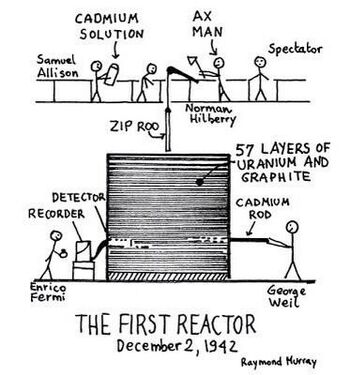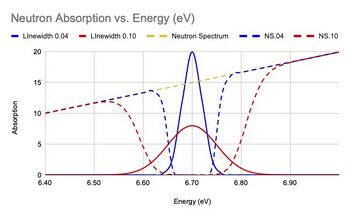User:David MacQuigg/Sandbox/Reactor Safety: Difference between revisions
(Add section on decay heat) |
m (add "fundamental") |
||
| (10 intermediate revisions by the same user not shown) | |||
| Line 1: | Line 1: | ||
{{TOC|right}} | {{TOC|right}} | ||
Concern over '''nuclear reactor safety''' is one of the four big barriers to acceptance of nuclear power discussed in [[Nuclear_power_reconsidered]]. | |||
To avoid endless debate over misleading allegations, discussions of reactor safety are best done in the safety sections of the article on each reactor.<ref name=ThorCon/> That said, there are fundamental features of many modern reactor designs requiring some technical understanding. This article will focus on those features. | |||
==Safety of Early Reactors== | |||
{{Image|Reactor Safety cartoon.jpeg|right|350px|Add image caption here.}} | |||
The critical safety mechanism of the first reactor (See Figure 1) and of many old generation reactors still in use, is the rapid insertion of neutron absorbing materials, either rods or solutions, shutting down the chain reaction. These mechanisms can fail, due to operator error, jamming of the rods (as happened at Chernobyl) or some other technical failure. | |||
==Criticality and the Role of Delayed Neutrons== | ==Criticality and the Role of Delayed Neutrons== | ||
| Line 24: | Line 29: | ||
===Melt Plugs=== | ===Melt Plugs=== | ||
Very | Very reliable with liquid fueled reactors | ||
===Continuous Draining=== | ===Continuous Draining=== | ||
Fuel drains out without continuous pumping to replenish.<br> | Fuel drains out without continuous pumping to replenish.<br> | ||
Even | Even more reliable than melt plugs that could get clogged or not melt quickly enough. | ||
==Intrinsic Safety - Negative Temperature Feedback== | ==Intrinsic Safety - Negative Temperature Feedback== | ||
===Thermal Expansion=== | ===Thermal Expansion=== | ||
Even a small drop from 1.00000 will shut it down.<br> | |||
What is <math>{alpha}_{K}</math>: pcm/K | |||
===Doppler Broadening of Neutron Absorption Lines=== | ===Doppler Broadening of Neutron Absorption Lines=== | ||
{{Image|Neutron Absorption vs. Energy (eV).jpg|right|350px|Fig.1 Higher temperature (red) broadens the absorption lines (solid curves). Broader lines punch bigger holes in the neutron spectrum (dashed lines).}} | {{Image|Neutron Absorption vs. Energy (eV).jpg|right|350px|Fig.1 Higher temperature (red) broadens the absorption lines (solid curves). Broader lines punch bigger holes in the neutron spectrum (dashed lines).}} | ||
Latest revision as of 10:20, 13 August 2024
Concern over nuclear reactor safety is one of the four big barriers to acceptance of nuclear power discussed in Nuclear_power_reconsidered. To avoid endless debate over misleading allegations, discussions of reactor safety are best done in the safety sections of the article on each reactor.[1] That said, there are fundamental features of many modern reactor designs requiring some technical understanding. This article will focus on those features.
Safety of Early Reactors
The critical safety mechanism of the first reactor (See Figure 1) and of many old generation reactors still in use, is the rapid insertion of neutron absorbing materials, either rods or solutions, shutting down the chain reaction. These mechanisms can fail, due to operator error, jamming of the rods (as happened at Chernobyl) or some other technical failure.
Criticality and the Role of Delayed Neutrons
Can it go BOOM ???
SL-1 - Don't yank the rods !!
Chernobyl - Soviet era incompetence, never again !!
Margin of Safety
Decay Heat
Show plot of heat generation (MegaWatts) before and after shutdown.
Engineered Safety Systems
Defense in Depth
Many layers of redundant systems
Plan for every possible human or machine failure
Passive Safety Features
Decay Heat Tolerance
Pool type reactors can absorb it all.
Convection Cooling
Removes decay heat even when the pumps fail
Melt Plugs
Very reliable with liquid fueled reactors
Continuous Draining
Fuel drains out without continuous pumping to replenish.
Even more reliable than melt plugs that could get clogged or not melt quickly enough.
Intrinsic Safety - Negative Temperature Feedback
Thermal Expansion
Even a small drop from 1.00000 will shut it down.
What is : pcm/K
Doppler Broadening of Neutron Absorption Lines
from Jack Devanney's Nuclear Magic: Where's the Throttle?
There is a widespread belief that nuclear reactors cannot loadfollow. This is nonsense. In most countries, loadfollowing is a grid requirement. In fact, stable reactors are inherently loadfollowers. A stable reactor is one whose power decreases as the reactor temperature increases. This is the property of any well-designed nuclear reactor, and a strongly enforced, legal requirement.
A few early designs could be put in a state where the opposite was true, an increase in core temperature increased power which increased temperature which increased power, which ... and the whole thing goes boom. One such design was the Russian RBMK at Chernobyl. You had to work pretty hard to put the RBMK in such an unstable state; but human ingenuity was up to it, and we got the Chernobyl explosion.
All temperature stable nuclear reactors have a remarkable ability. They automatically adjust their power output to the load. If the electric load increases, the turbine control system will speed the steam flow up. The increased steam flow will extract more heat from the steam generator. This will decrease the temperature of the reactor coolant. The reactor core temperature will drop, and the reactor will increase power, without us doing anything. It's built into the physics.
Conversely, if the load drops, temperature increases, and reactor power decreases.1 If the loads drops completely, say due to a station black out, the reactor temperature will shoot up, and the reactor will shut itself down. The shutdown does not depend on a system that senses a problem and then tries to react to it. There is nothing a confused operator or malfunctioning control system can do to prevent this process.
Further Reading
Till & Chang, Chapter 7: Safety
Jack Devanney's Substack: Nuclear Magic: Where's the Throttle?
Notes and References
- ↑ See the the Safety section of the ThorCon article, and its Debate Guide page for example.


